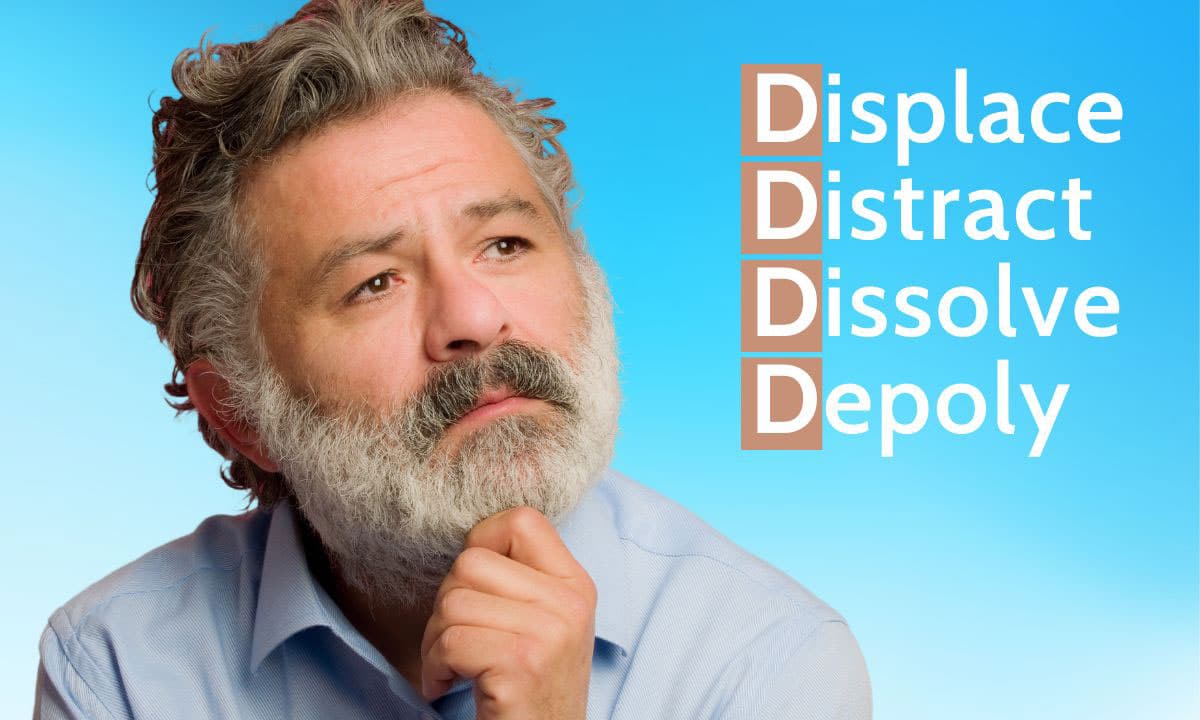
What is My Role in This?
Being curious allows you to ask, “What is at the root of what is going on here?” and “What is my role in this?”
Stan Learns About Resilient Leadership.
In our June Practice of the Month, we revisited Stan and learned a bit more about the Four Ds. The Four Ds refer to four techniques people often use to deal with their anxiety. They are Displace, Distract, Dissolve, and Deploy.
Stan was recently promoted to a new job and is now heading up a new team at his place of employment. In addition, he now reports to a new supervisor who replaced his former long-time “old buddy” boss. With so much change in his work life, his level of apprehension about his future has gone way up. Chronic anxiety has caught Stan’s attention.
We described the first two Ds as unhealthy choices Stan made as he tried to Displace or Distract himself to manage his discomfort. The first behavior seeks to Displace anxiety, and it includes gossip. He has since learned that gossiping about others whom he, at first, thought were the cause of his anxiety is damaging to himself and others. Stan now realizes that gossiping simply creates more problems.
The second behavior is to Distract oneself from anxiety. Stan is learning to recognize the times he tried to relieve his chronic anxiety through procrastination, overindulgence in food, alcohol, or excessive television. These behaviors to Distract oneself from chronic anxiety proved to be unhealthy as well.
As Stan continues to learn that attempting to Displace or Distract chronic anxiety are not the best options, he’s beginning to choose behaviors that are healthier. Behaviors that Dissolve or Deploy chronic anxiety work more effectively. He’s making small changes over time, realizing that trying a lot of changes all at once will increase his chronic anxiety!
Dissolve: Exercise, meditation, and reading quality literature fall into the Dissolve category of actions. Stan and his spouse already go on evening walks with the dog, and he’s had a routine of reading before bed to unwind. Recently, Stan has taken up meditation. Because family mornings can be hectic, Stan has begun getting up 20 minutes before the family wakes up. He may be getting up earlier than he used to, but the feeling of well-being that meditation has brought him is so rewarding he understands its benefit to him. The meditation app Stan uses has taught him to pause a few seconds when anxious at work and at home to calm himself by being mindful. Stan starts by taking slow, deep breaths. Next, he’s learning to think about his thinking. He is learning to observe his thoughts for what they are – just thoughts, not hard facts. No judgment, no criticism; not “I’m angry” or “I’m happy” because Stan knows he is not his thoughts. By observing these thoughts or emotions as “oh, anger” or “oh, joy,” he can now choose to respond in a way that makes him and the people around him feel more at ease and more connected.
Deploy: How good are you at facing a perceived threat with calm? Some of us will immediately say, “Not great.” Stan would agree. Having an open and curious mindset in the face of a perceived threat allows new pathways to emerge as alternatives to simply reacting to every perceived challenge. With a curious mind, Stan can ask himself, “Is this actually a threat at all?” Many times, after learning to calmly observe a situation, the answer is “Not really”. Stan is learning how not to be reactive to challenging situations as he deploys a new mindset.
Wrapping it Up. Most neuroscientists would agree that 95 – 99 percent of our day-to-day behavior is unconscious and instinctual, and/or habitual. When we allow our racing minds to perceive circumstances as threats, of course, we’re anxious. In addition to meditation, how do we calm our racing minds? One suggestion is detached curiosity. Instead of unconsciously reacting to each situation, be intentional in your curiosity. Focus on facts; what is known and what is unknown? Avoid speculating about causes or motives. Do not make assumptions.
Being curious allows you to ask, “What is at the root of what is going on here?” and “What is my role in this?”
These questions allow us to develop a calm, curious mindset. Over time our thoughtful, less reactive mindset allows us to become a Less Anxious Presence. This is when one is truly able to “Stay Calm, Stay the Course, and Stay Connected!”
We explore these principles and behaviors in our Resilient Leadership courses. The concept of calming yourself is what we call Six-Second Centering. Learning how to “see” the Emotional System leads to looking at the root causes of anxiety and asking, “What is my role in this?” When we understand our role in lowering chronic anxiety, we avoid behaviors that attempt to Displace or Distract anxiety, and we can then choose healthy behaviors that Dissolve and Deploy it. As we learn to develop mindfulness and think about our thoughts, we can choose to practice a detached curiosity. Our calm demeanor and curious, non-reactive mindset convey a Less Anxious Presence to those we meet.
Come join Stan and the rest of us who are learning to Stay Calm, Stay the Course, and Stay Connected with Resilient Leadership!

Mike Nowland is a persuasive and empathetic communicator with over 30 years of senior-level experience in Leadership Development and Human Resources with companies like Marriott International, ResMed, and Kisco Senior Living.

John Moyer has 30+ years of experience training and coaching both student and adult leaders. His focus is primarily on individual coaching along with targeted training engagements as a complement to his teaching career.
Unleash Your Leadership Power with our Webinar Series
- Dig into our overview of 6 key concepts of Resilient Leadership in our upcoming Webinar Series
- Join us on our leadership pathway to develop and learn how to lead others and your team more effectively. See, Think, and Lead Differently.
- Sign up up now for our July 12 Webinar

